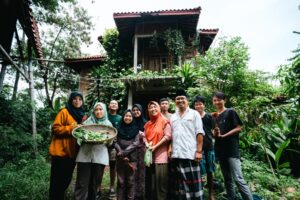
Agricultural Transformation starts in the backyard: The story of Nissa Wargadipuras from Indonesia
Nissa Wargadipuras’s earliest memories involve learning how to live with nature. Her childhood home’s backyard in the hilly town of Garut, West Java was a little forest where her father planted vegetables, herbs and fruits. Her mother produced traditional medicine from the plants for their family and their neighbours.
“Whenever I came home from school, my mother always asked me to do some “hunting,” Nissa says. The tradition of the “backyard hunt” has long been part of ethnic Sundanese life in West Java, Indonesia. “I ‘hunted’ guava, coconut, turmeric, cayenne pepper, everything. I could find all that I needed in my parent’s backyard.”
Sundanese people in Nissa’s village consider their homes not only a place to rest and take shelter, but also a means to provide them food and make a living.
Nissa’s idyllic memories of her Garut childhood speak to the deep roots of family farming in rural Indonesian life. But her struggles to maintain those traditions against political adversity and poverty are illustrative of the threats family farmers have faced across Indonesia.
Searching for solutions
Nissa was a high school student in 1989 when she first realized that her family’s livelihood—and that of other farmers in Garut—was threatened. She joined a student movement to protect the rights of local farmers and resist the government’s policy of land acquisition.
Eventually, the struggle yielded results. “Finally, in 1997, around 700 farmers got their land back,” she said.
The following year, Nissa and her friends established the “Pasundan Farmer Union”. The organization became one of the most influential farmers’ organizations in West Java, and today it has more than 100 000 members. Getting their land back was the first step, but it didn’t protect farmers from the ravages of poverty.
Nissa experienced the desperation firsthand when she lived with a farming community at the foot of the Papandayan mountain in West Java. Farmers planted vegetables based on orders from intermediaries who controlled the city’s central market. These intermediaries provided farmers with seeds, agrochemical fertilizers and vitamins. They also encouraged farmers to move towards monoculture to reach their production targets. The high costs of the inputs increased the farmers’ dependency on the intermediaries, and when the price of vegetables dropped, farmers were left with little means of subsistence.
Not an ordinary school
Nissa decided to find a way to empower the farmers, decrease their dependency on intermediaries and rekindle the experience of living close to nature.
But the only way farmers and their children would regain confidence in their traditional wisdom, Nissa reasoned, was through education. In 2008, Nissa and her husband established a farmer field school called At-Thariq (meaning “the way” in Arabic) to teach agroecology, food security and religion to young people. Students also enrolled in traditional schools for formal education.
Students sleep and eat at the school. They also receive sustainable farming lessons, learning mainly by doing.
On only one hectare of land, Nissa designed a planting system based on intercropping, where various crops are cultivated simultaneously in the same field. The planting area is divided into several zones: a zone for tropical fruits, a fishpond in another zone and a staple food zone where they grow cassava and taro. The school also grows a variety of vegetables such as tomatoes, water spinach and herbs.
Activities begin at 4 a.m. with morning prayers. After that, the high school students prepare for school, while the college seniors prepare food for breakfast and lunch and harvest the vegetables, fruit and fish that would be needed for dinner. In the afternoon, the elementary students tend the farm. In the evening, they learn more about agriculture and on the weekend, they spend all day on the farm. The school only admits 30 pupils because the farm can only feed 30 people.
“Students must eat from the farms that they manage. This is one of our main lessons,” explains Nissa.
Close to home
Nunung Nurhasana spent five years at At-Thariq during high school and college. After graduating from the college of education in Garut, she returned to her village. Armed with her studies and experience from At-Thariq, Nunung applied the ideas that she learned.
Nunung’s village produces a variety of fruits such as bananas, papayas and coconuts. She and the women farmers in her village process the leftover fruit into snacks and beverages, which she then promotes and sells on social media.
Nunung says she spends very little on meals because, “I have everything I need in my family’s backyard.”
At-Thariq has more than 1 000 alumni. Most, like Nunung, stay in their village and apply the lessons they learned.
Family farming
“Nissa’s journey offers some solutions to many of the challenges facing us in our efforts to create more sustainable and resilient food systems,” says Pierre Ferrand, FAO’s focal point for family farming in the Asia Pacific region. “Family farmers must be at the heart of agricultural transformation.”
Family farming preserves traditional food products, contributes to a balanced diet, uses natural resources sustainably and safeguards the world’s biodiversity. Through its Family Farming Initiative as part of the Decade of Family Farming, FAO encourages living examples, like Nissa’s, of the values and lifestyles that concretely help the world attain a more sustainable future.
The seeds of agricultural transformation that Nissa planted 12 years ago have started to bear fruits. And it all started in her backyard.
Note: Orginally published in FAO website



